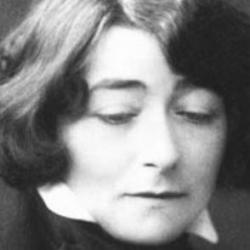
Eileen Gray
Eileen Gray, born on 09.08.1878 in Brownswood (Ireland) was an extraordinary woman. In the then "children's kitchen church" law time Gray moved away and went into the professional world. Her autodictic knowledge lead to her success as an interior and furniture designer. She achieved all her success without a degree.
Eileen Gray's father died in 1900, at which time she had already been learning the trade of a draftswoman at the Slade School of Fine Arts in London for two years. In 1902 Gray moved to Paris where she continued to devote herself to the arts of drawing and oriental lacquer work.
In 1907 Gray rented an apartment at 21 Rue Bonaparte, which she kept until the end of her life. In Paris, Gray met the Japanese Sugawara, who introduced her to the art of East Asian lacquer. It was not until six years later that Gray dared to show her own work at an exhibition of interior designers. Gray's work caught the interest of couturier Jacques Doucet - an art connoisseur and collector at the time.
Doucet was refurnishing a house at the time. The style of the interior was to move away from 18th century art to modernism. Eileen Gray made two tables and a screen for the Doucet house. These works were dated and signed by Gray.
At the outbreak of World War 1, Eileen Gray returned to London and worked as an ambulance driver. After the end of World War 1, Gray returned to her old creative home in Paris and reopened her workshop. Her first major commission was to design the Rue de Lota apartment of Madame Lévy, who was also known as Suzanne Talbot.
In 1922 Gray opened the Galerie Jean Désert in the Rue du Faubourg St. Honoré. There she exhibited and sold her furniture, screens and lamps.
With her "bedroom-boudoir for Monte Carlo" Gray caused controversial criticism in the Paris press in 1923. Among the followers of the "de Stijl" movement, however, for the highest recognition. Gray also received encouragement from Gropius, Le Corbusier and Mallet-Stevens. On that basis, she ventured into architecture.
After several years of learning, Gray built a house for herself in Roquebrune under the advice of architectural theorist Jean Badovici. Well thought out with clever interior solutions and details provided. The other two projects Gray designed also impressed with their inventiveness and practicality.
However, further designs were not realized. Until her death in 1976, Gray worked on various newly conceived projects and always tried new materials. At the age of 80, Gray converted a barn near Saint Tropez into a summer house.
Shortly before her death, Eileen Gray had an exhibition of her most important works at the Museé des Arts Décoratifs in Paris. On 28.11.1976 Gray's eyes closed forever.
1878: Eileen Gray was born in Ireland August 9, 1878, on the family estate of Brownswood in Enniscorthy (Wexford).
1898: Gray moved to London to study painting at the Slade School of Fine Arts
1907: She finally moves to Paris after several previous visits and learns the Japanese lacquer technique.
1914: After the outbreak of World War I, she travels back to London.
1918: Gray moves back to Paris
1922: she opens a studio for interior decoration and furniture design
1925: Eileen Gray made her breakthrough (internationally) with her functional designs for tubular steel furniture
1927: she designed the house E 1027 which was then built in Roquebrune (France). For this object she also designed the now famous height adjustable side table "E1027".
1972: The first retrospective of Eileen Gray is shown in London.
1976: On 28th November 1976 Eileen Gray died in Paris

 Deutsch
Deutsch
 English
English